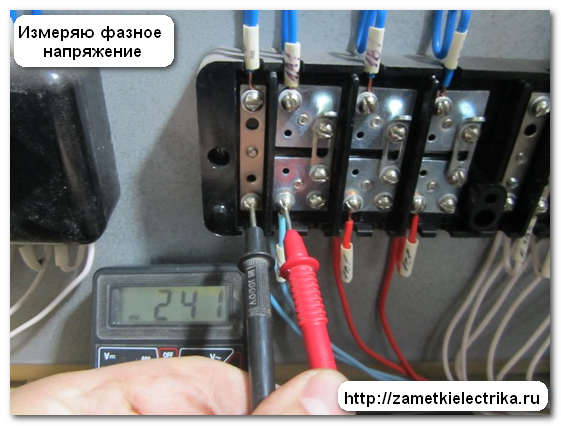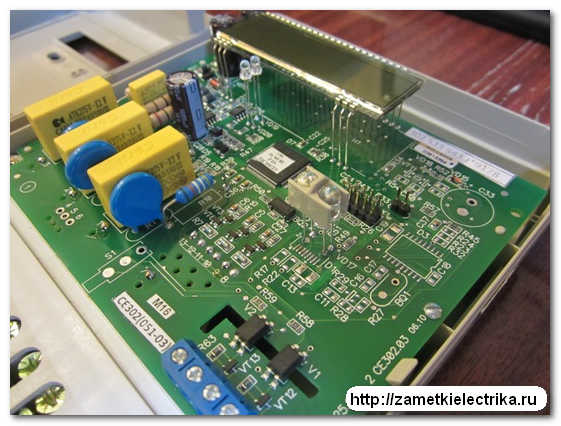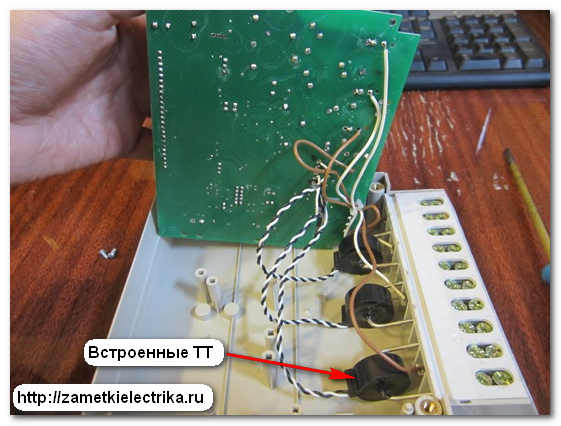Hello, dear readers and visitors of the Electrician's Notes website.
Today two of them failed at once. three-phase meters Energy meter CE 302.
This happened on the incoming feeders of the complete transformer substation(KTPN).
Meter type - Energy meter series CE 302 S33 543-J (three-phase, single-tariff active and reactive energy meter, connected via current transformers).

Here is their transcript and specifications(from the manual):


The operational staff, represented by those on duty, came to take the readings and found that the following inscription was displayed on the display of both meters instead of the readings: “Err 01”.


They immediately contacted me and relayed the comment. To be honest, I have never encountered anything like this before, so I opened the manual for this meter to decipher the code of this system error, because they inform us about serious irregularities in the operation of the meter.
In my case: “Err 01” means low supply voltage.
Next comes instructions to double-check the meter connection diagram and ensure that its type matches the mains voltage. No one touched or changed the circuit; the network voltage meter was selected correctly (3x220/400V). And it has worked from 2010 until today without any complaints.
I decided to go to the substation and check the voltage level in the network. What if the voltage is really low!!! I opened the seal of the transition test box (more details), measured the phase and line voltages using a digital multimeter.

Got the following values:
- A - 241 (B), B - 242 (B), C - 241 (B)
- AB - 416 (B), BC - 417 (B), SA - 417 (B)
Then I tried using jumpers to turn off the voltage from the meter and turn it on again.

Nothing has changed, the error has not disappeared from the screen. The reason for the failure of the meters is not known to me; both inputs to the KTPN are operated separately and are in no way connected with each other. No surges or drops in voltage in the networks were noticed (from operational logs and telemechanics event recorders).
I saw a similar case on one of the forums. When contacting the Energomer company, they received the following answer: “The meter failed, most likely due to a defect in the built-in power supply.”
And yet it turns out that they know about such malfunctions. The question then arises - is this warranty case(defect due to the manufacturer) or will repairs be carried out at the expense of the consumer?
P.S. In general, I plan to replace them tomorrow and send them for repair. I would like to know from you who has encountered a similar situation?
Addendum 1:
Yesterday I took the meter and cut off two lead seals and protective holograms from its body.




Then he unscrewed the two mounting screws and removed the meter cover.




As you can see, this meter model does not have a battery. Just in case, I checked with reverse side printed circuit board, but nothing there either.

But you can see how the voltage circuits are connected (brown and white wires) and the built-in current transformers for each phase. Secondary circuits CTs are made of pigtails of black and white wires.
This means that all options with low “battery” are eliminated. There is only one conclusion - the power supply has failed.
The yellow ones in the diagram are CARLI .47K 275V~X2 MPX40/100/21 noise suppression capacitors.

Addendum 2:
I present to your attention the correspondence with the support service of ZAO Electrical Plants Energomera.
Good morning. I'll tell you briefly the situation. KTPN - simultaneously on two inputs on the meters CE302 S33 543-J 220/380 (V) 5 (A), instead of readings on the display, the error “Err 01” appeared. According to the manual, I deciphered it as “low voltage”. The voltage in the network has a normal permissible value. The inputs are completely independent from each other and work separately. Please tell mewhat is the reason for this error? Meters manufactured in 2011. Thank you.
Hello. Your meter is out of order. There are defects in the power supply, the power supply to the meter circuits is too low. You need to send a faulty metering device of our production by mail to the manufacturer at the address: 357106, Stavropol Territory, Nevinnomyssk, st. Gagarin 217, for spare parts "Energomera".
Sending a warranty device at the expense of the recipient (as a rule, postage costs are included in cash on delivery). Attach to the parcel a copy of the malfunction report (if any) and a letter of application, in which you describe in free form: where the device was used, when the malfunction was discovered, and also indicate your correct return postal address to which a working device will be sent to you.
The application must be submitted to the head of the bureau warranty service— Podshibyakin Dmitry Alexandrovich.
Sincerely, Consultant for work with consumers Babenko T.S. ( [email protected]).
Now I’m thinking whether to send them a second counter or not; anyway, I’ve already installed a TsE6803V in their place.
A large error in induction counters can be caused by the following reasons:
high voltage drop in voltage circuits
A significant meter error appears when the voltage deviates from the nominal voltage by more than 10%. When the meter load is less than 30%, a decrease in voltage leads to a change in error in negative side due to weakening of the friction compensator. At loads of more than 30%, a decrease in voltage leads to a change in error already in positive side. This is due to a decrease in the braking effect of the work flow and voltage.
It happens that counters with rated voltage 380/220 V is installed in a network of 220/127 or even 100 Volts. This cannot be done for the reasons stated above. The rated voltage of the meter must correspond to the actual voltage.
incorrect meter switching circuit
Errors in electricity metering occur when correct alternation phases There may be an error in both a positive and negative direction.
non-compliance with normal operating conditions of the meter
The accuracy of the metering is affected by the position of the meter. The main disk of the meter must be strictly vertical. A deviation of more than 4° introduces an additional error due to a change in the friction moment in the supports. The position of the counter and the plane on which it is installed is checked along three coordinate axes.
Influence of external magnetic fields on the meter reading
To avoid the influence of external magnetic fields, the meter should not be installed near powerful current conductors, welding machines, powerful magnets and other sources of significant magnetic fields. For example, if you bring a neodymium magnet to the meter, then its error will be up to 100%, both less and less. big side depending on the place of presentation.
Other causes of induction meter malfunction
A malfunction of the electric meter can occur suddenly under the influence of sharply unfavorable influences. These may include shocks and shocks, prolonged overloads, short circuits, lightning and switching overvoltages.
The meter can also gradually become faulty before the time between repairs expires. As a result of premature wear caused by unfavorable conditions operation, appear various defects: corrosion permanent magnet, electromagnet cores and others metal parts, clogging of the gaps in which the discs rotate, thickening of the lubricant; loosening of parts.
When taking meter readings, it would be good to make sure that it is in good working order.
Condition of contacts at connection points
An unreliable connection leads to heating and burning of contacts, destruction of insulation and sparking. Such contacts must be cleaned of soot and tightened tightly.
Damage to the meter housing
Electrical equipment with damaged housings cannot be repaired and must be replaced with a new one. Electric meters must not have damage to the housing, sight glasses and terminal covers.
Checking the serviceability of the meter
The serviceability of the meter is determined simply by the rotation of the disk. When switched off, the electric meter disk should stop making no more than one revolution. If the disk continues to rotate after turning off all receivers, then you should call an electrician who will remove the meter and recheck it at the appropriate organization.
Damage to electrical conductor insulation
If, during testing, the meter turns out to be in working order, but when the load is turned off, the disk continues to rotate, this means that the insulation of the electrical conductor is damaged and there is a current leak. In this case, it is necessary to stop using electricity, determine the location of the damage to the wiring, and eliminate power leakage.
Counter overload
External signs Overloads of the meter are a specific smell of burnt insulation, abnormal humming of the meter, yellowing of the glass of the viewing window. The buzzing of the counter, if it is not accompanied by arbitrary rotation of the disk, is not a sign of its malfunction.
Checking the correct meter readings
To determine whether the meter reading is correct at home, it is recommended to turn off all lights, heating devices and other consumers of electricity (computer, refrigerator, washing machine, etc.). Then, for 10-15 minutes, turn on one consumer with a known power, for example an electric lamp, and determine the actual electricity consumption, which should coincide with the meter readings, taking into account the latter’s error.
Experts recommend doing a home check after returning the meter from state verification, since the disk rotation speed may be slightly increased, and as a result, the electric meter will show incorrect electricity consumption.
The meter can also show increased energy consumption when high humidity.
Counter electrical energy - is an electrical measuring device designed to account for consumed electricity, alternating or direct current(measured in kWh).
Electricity meters that take into account active electricity are called active energy meters.
Electricity meters that take into account integrated reactive power for the accounting period are called reactive energy meters.
Electrical energy units:
- active electrical energy – 1 kWh (kilowatt per hour),
- reactive electrical energy – 1 kVArh (kilovar per hour),
For electric meters must be observed temperature regime in accordance with the data in the manufacturer's passport.
Technical characteristics of electricity meters
The technical characteristics of electricity meters are determined by the following main parameters:
- rated voltage,
- rated current,
- accuracy class of the electric meter.
Rated voltage and rated current of electric meters– indicated as the product of the number of phases by the rated values of current and voltage. For example - 10-50 A; 3X380 / 220 V this means that the electricity meter is designed to be directly connected to three-phase network with a rated voltage of 380 / 220 V and a rated current of 10-50 A.
Electric meter accuracy class is its greatest permissible relative measurement error, expressed as a percentage. Induction active energy meters are manufactured with accuracy classes 0.5; 1.0; 2.0; static watt-hour meters (electronic) – accuracy class 1.0; 2.0; 0.5 and 0.2. The accuracy class of reactive energy meters can be one step lower than the accuracy class of the corresponding active energy meters.
Induction(electromechanical electric meter) is an electric meter in which the magnetic field of stationary current-carrying coils influences a moving element made of conductive material. The moving element is a disk through which currents induced flow. magnetic field coils The amount of electricity consumed, in this case, is directly proportional to the number of revolutions of the disk.
Electronic(static electricity meter) is an electricity meter in which alternating current and voltage act on solid-state (electronic) elements to create output pulses, the number of which is proportional to the measured active energy. That is, active energy measurements with such electricity meters are based on the conversion of analog input signals of current and voltage into a counting pulse. Measuring element electronic electricity meter serves to create pulses at the output, the number of which is proportional to the measured active energy. The counting mechanism is an electromechanical or electronic device, containing both a storage device and a display.
One of the main advantages of electronic electricity meters is the ability to meter electricity at differentiated tariffs (one, two or more tariffs), which is provided using a tariff switching device. A multi-tariff electronic electricity meter is an electrical energy metering device equipped with a set of counting mechanisms, each of which operates at set time intervals corresponding to different tariffs.
Choosing an electricity meter
Currently, a fairly large range of electricity meters are produced in Russia. They can be single- or multifunctional; they allow you to work with one or several tariffs at once, i.e. differentiating them by time or other indicators. As a rule, the consumer has to make the main choice between induction and electronic electricity meters, which can be with a mechanical or liquid crystal reading mechanism. Electronic electricity meters are characterized by higher accuracy and reliability compared to induction electricity meters.
When choosing an electric meter, it is most important to pay attention to the electricity meter tariff and accuracy class. An electric meter can be single-tariff, two-tariff or multi-tariff. Two-tariff electricity meters make it possible to save money when paying for electricity, since set time they automatically switch to the night rate, which is lower than the day rate. The two-tariff payment system assumes separate tariffs for the day (from 7:00 to 23:00) and night (from 23:00 to 7:00). Since the night tariff is significantly lower than the day tariff, this makes it possible to significantly reduce electricity costs (especially when switching to night mode such energy-intensive devices as washing machines or electric heaters).
Electricity meter malfunctions
When inspecting apartment panels, it is necessary to pay attention to the condition of the contacts at the points of connection of electrical equipment (switches, electricity meters, and so on). An unreliable connection leads to heating and burning of contacts, destruction of insulation and sparking. Such contacts are cleaned of soot and tightened tightly. Circuit breakers and fuse links must match the loads and cross-sections of wires and cables. Devices with damaged housings cannot be repaired and must be replaced with new ones. Electric meters must not have damage to the housing, sight glasses and terminal covers.
The serviceability of an induction electric meter can be determined by the rotation of the disk. When the load is disconnected, the electric meter disk should stop making no more than one revolution. External signs of an electric meter overload are a specific smell of burnt insulation, abnormal humming of the meter, and yellowing of the glass viewing window. A meter whirring sound, unless accompanied by self-propelling, is not a sign of malfunction. The serviceability of the electronic electricity meter is determined by the blinking of the LED. When the load is disconnected, the LED blinking should stop.
The electric meter may show increased electricity consumption at high humidity. The insulation of the wiring deteriorates over time, and many microcracks form on it, through which electricity leaks. damp wall. The more moisture deposited on the wall surface, the higher the leakage voltage, and the possibility short circuit becomes quite real.
Before connecting any household appliance You must make sure that the voltage for which the electrical appliance is designed matches the mains voltage. Electrical appliances that do not match the mains voltage must not be connected to the network.
Checking the electricity meter readings
The electricity consumed by all electrical appliances in the apartment is metered using an electric meter. Based on the readings of the electricity meter, the payment for the use of electricity is calculated.
If there is any doubt about the correctness of the electric meter readings, it can be easily checked.
To do this, you must first disconnect all lamps, appliances, and radios in the apartment from the network and make sure that the disk of the induction electric meter, which is visible in the viewing window, does not rotate or the LED of the electronic electric meter does not light up. If the disk continues to rotate (and the LED of the electronic electricity meter blinks), this means that somewhere there is an electrical appliance that is not turned off. It must be turned off, otherwise you won’t be able to check the electric meter.
For 10-15 minutes, turn on one electrical appliance with a known power, for example an electric lamp, and determine the actual electricity consumption, which should coincide with the meter readings, taking into account the latter’s error.
Electric meter installation
It is necessary to install an electric energy meter only with the consent of the energy sales organization and only by a representative of an organization licensed to carry out this work. It is not recommended to install an electric meter yourself. If you already had an electric meter installed and you just want to replace it, then remember that unauthorized dismantling of the old electric meter is a violation of the contract with energy supply company and a broken seal on an old electric meter entails a change in the payment procedure.
After installing the electric meter, it must be registered, for which you need to invite a representative of the energy supply organization, who, after making sure that everything is done correctly, will accept it into operation and seal it, take the initial readings of the electric meter and give permission to use it. From now on, payments for electricity will be carried out in accordance with the readings of the new meter.
